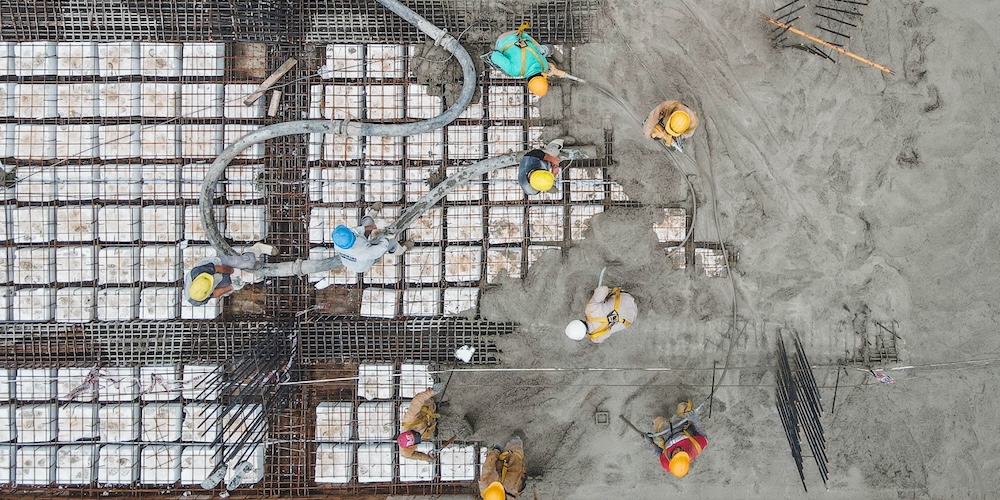— 8 min read
Construction Project Management Milestones
Last Updated Sep 9, 2024
Last Updated Sep 9, 2024

Completing a construction project on schedule, on budget and at a high level of quality doesn’t happen without good planning, and good planning is tough to pull off without an understanding and command of project milestones.
Project milestones are critical dates or activities in a construction schedule that can be used to plan and track the progress of a project. Common milestones include the start and finish of a project, the completion of important phases of work and project handover.
This article explores project milestones, including how to identify them, common examples — and how they can improve project management.
Table of contents
The Importance of Milestones in Project Management
Construction projects involve hundreds, or even thousands, of individual tasks or activities. Implementing project milestones helps site leadership identify specific dates or activities on the schedule that signify completed work phases, indicate the start of others, and simplify and improve essential components of managing the project.
Below are key ways milestones are used to facilitate a smoother project completion process.
Planning
Milestones can be used to create an effective construction schedule that enhances a project manager’s abilities to find flex time in the project and identify and preemptively address potential delays.
By creating markers for phases of work, milestones can help to identify what resources are needed and when.
Communication
Milestones can be shared reference points that make it easier to communicate objectives, priorities, and progress to every person on a project. Milestones show how the completion of one part of a project triggers the beginning of another, which helps people understand how their work fits into the project and the importance of avoiding delays.
Progress Tracking
Having effective and transparent milestones allows all stakeholders to identify how a project is progressing, especially in relation to where a project needs to be to finish on time. Being able to identify whether a segment of work is behind or ahead of schedule can help contractors and project managers adjust schedules or create contingencies as needed.
For owners, milestones can be referenced to understand a project’s progress, without needing to familiarize themselves with a project’s seemingly infinite number of tasks.
Connection to Payment
Payment to contractors can sometimes be connected to hitting milestones, specifically substantial completion, which is often required for final payments or the release of retainage.
Stay updated on what’s happening in construction.
Subscribe to Blueprint, Procore’s free construction newsletter, to get content from industry experts delivered straight to your inbox.

Implementing Construction Project Milestones Onsite
A common milestone in the construction of a building is foundation completion, which may help some stakeholders better understand the steps required to complete a milestone.
Completing the foundation means a project is safely up to podium level and the rest of the project, specifically structural framing, is safe to begin. It also means that many tasks, such as excavation, dewatering, or construction of underground parts such as a parking garage, are completed and have been checked for quality and safety.
For a building that requires underground work, for example, the foundation completion step would be split into two separate milestones. In this case, the first milestone would be completed once the bottom slab or pile caps are done, then the garage can be built. Once the podium is reached and the shoring used to support the pit during underground construction is no longer a risk, then the second milestone is achieved.
Foundation completion signals the project manager that it’s time to plan equipment return, wrap up work from specific subcontractors, and end safety precautions required for a job with an open pit. If this milestone is delayed, perhaps due to a rainstorm, the project manager can reference their schedule to anticipate other phases of work that will be impacted. They can also share an adjusted timeline with stakeholders.
Choose Checkpoints that Show Progression
Project managers usually use the same milestones for most projects, which can help make planning and communication easier. Commonly, milestones include the start and finish date of the project, activities or dates that signify the end of a phase of construction and allow for the beginning of another, or handover. Projects with unique uses will often have unique milestones, such the installation of a medical gas system in a hospital.
Most of the dates associated with milestones are determined by the project manager, which allows them to account for the specific needs of each project. Project managers have many techniques to help determine milestones, such as the critical path method or pull planning.
Perhaps the most common and important project milestone is substantial completion, which is often the only milestone mentioned in a contract. The rest of the milestones are usually determined and sequenced to arrive at the target date for substantial completion.
Common Project Milestones Used in Construction
There are different ways to approach milestones, depending on the type of planning technique being used. The Project Management Institute (PMI) breaks down most construction projects into five phases, which are initiation, planning, execution, monitoring and control, and closeout. Some contractors simply divide their projects into three phases: pre-con, construction, and closeout.
However a contractor divides a project, milestones help to create meaningful markers within those phases that can be tracked and planned for. Here are some common examples:
- Project initiation, which might include contract execution, entitlement, and buyout
- Foundation completion, including excavation and getting back to podium level
- Structural framing, which might include topping out
- Enclosures, specifically a building being dried-in/weatherproofed
- Elevators, which releases personnel and material hoists and triggers the rest of the building being closed
- MEP (Mechanical, Electrical, Plumbing) rough-in and commissioning
- Fire Suppression System installation and testing
- Interior/Exterior finishes
Indicators that Signify Milestone Achievement
Reaching most interim milestones requires completing all preceding tasks and checking them for quality and safety. Many milestones are activities that require inspections, which can determine whether the activity or preceding tasks have been completed safely and to specification.
The exception to this is substantial completion, which usually has more rigid criteria and is more likely to have a predetermined target date than other milestones. Achieving substantial completion usually requires an owner and contractor to do a walkthrough together and agree that a building is ready for its intended use, even if minor work still needs to be done.
Consequences of Missing Project Milestones
Many things can cause a team to miss a milestone, ranging from delays in getting material, conflicting schedules, extreme weather conditions or simply misjudging how long a task should take. Many contracts include language that protects contractors from being held responsible for issues outside of their control.
However, missing a milestone is often a big deal, particularly if it impacts a team’s ability to hit the target date for substantial completion. Delaying substantial completion can lead to the building owner losing money, and, in worse-case scenarios, the general contractor having to pay liquidated damages. While there isn’t a particular punishment for missing most interim milestones, it should prompt a team to evaluate the impact on the rest of the project, decide if time can be made up in other areas and assess if the master schedule should be adjusted.
Some planning tools and techniques, such as the ones referred to below, or the Critical Path Method, can help identify which milestones are critical to a project finishing on time.
Software Tools for Efficiently Managing Project Goals
Most digital planning tools prominently feature project milestones as an important part of the planning process. Many of them, including Procore’s planning tools, use milestones to track spending, time, and materials.
Many digital planning tools offer the ability to build a milestone chart, which is a visual representation of a schedule and divides a project into phases, or a Gantt chart, which visually represents a project schedule through a bar chart.
These types of visual tools help to improve planning by showing tasks that might overlap, have slack time, or be prone to causing delays. Similarly, these charts are often easy to share with stakeholders, specifically clients, so they can feel informed and track progress of the project.
Stay updated on what’s happening in construction.
Subscribe to Blueprint, Procore’s free construction newsletter, to get content from industry experts delivered straight to your inbox.

Using Milestones to Improve Future Processes
A key to improving the planning process, especially when it comes to using project milestones, is building in time after a project to consider what went well and what could be improved. It’s always tempting to rush to the next job, especially when the end of one job overlaps with the beginning of another.
But making time to reflect, especially in regards to milestones that were finished with time to spare and those that were missed, can help improve the process on future jobs and result in better estimations for budgets and timelines.
One useful, and manageable, technique is to keep a list throughout of blockers that made it difficult to reach a milestone, or led to it being missed. Notes might include specific issues with material procurement, weather events, or tasks that needed more time.
Another technique is to have a debrief with key stakeholders as part of the closeout process to understand their perspective on what went well and what didn’t. This is a valuable practice in general, but can make it clear how to be more precise in creating milestones that are useful for planning but adaptable enough to avoid delays.
Was this article helpful?
Thank you for your submission.
90%
10%
You voted that this article was . Was this a mistake? If so, change your vote here.
Scroll less, learn more about construction.
Subscribe to The Blueprint, Procore’s construction newsletter, to get content from industry experts delivered straight to your inbox.
By clicking this button, you agree to our Privacy Notice and Terms of Service.
Categories:
Tags:
Written by
Colton Stokwitz
Colton Stokwitz is a Program Manager at Shoreline CPM. Based in San Diego, Colton spent 11 years working as a project controls manager, lead interior superintendent and senior cost analyst at Turner Construction. He has a Bachelors of Science (BSc) in Construction Management from California Polytechnic State University-San Luis Obispo.
View profileJames Hamilton
70 articles
James Hamilton is a writer based in Brooklyn, New York with experience in television, documentaries, journalism, comedy, and podcasts. His work has been featured on VICE TV and on The Moth. James was a writer and narrator for the show, VICE News Tonight, where he won an Emmy Award and was nominated for a Peabody Award.
View profileExplore more helpful resources

Construction Manager vs. Project Manager: Comparing Leadership Roles
Skillful oversight of construction projects allows companies to deliver to owners on time and within budget. Construction managers (CMs) and project managers (PMs) provide the necessary supervision to keep projects...

Mastering Construction Resource Management: Strategies for Success
Completing construction projects successfully requires the careful management of various resources: labor, materials, equipment, money, time and information. Since these resources are finite, allocating them wisely is crucial for minimizing...

Managing Construction Projects in Different States: A Contractor’s Guide to Working Across State Lines
For many general contractors, taking on work in a new state or region can offer transformative opportunities for building a thriving business and a respected reputation. But managing projects is...

Construction Teamwork: Build a Solid Foundation With the Right Team
Construction is an industry of collaboration — no one person completes any job on their own. It could easily be argued that the most important skill for anyone in this...